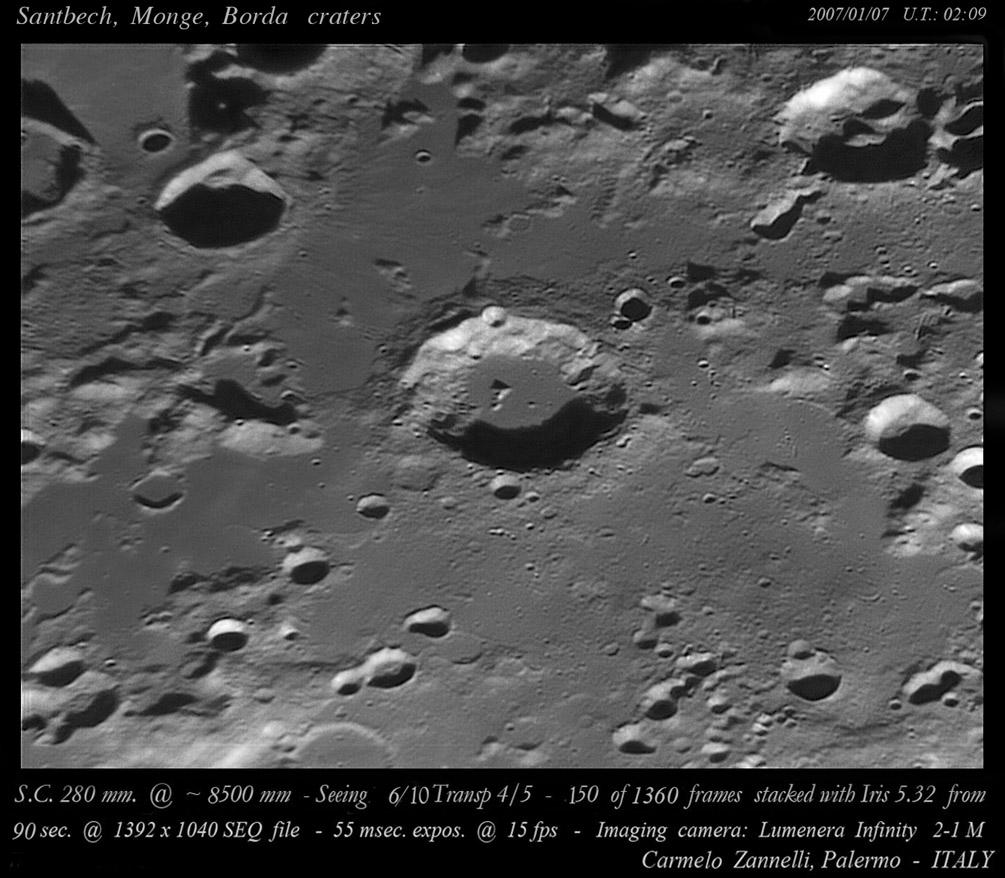Difference between revisions of "April 18, 2018"
(Created page with "__NOTOC__ =In the Moat= Originally published December 9, 2008 <!-- Start of content --> <!-- ws:start:WikiTextHeadingRule:1:<h1> --> <!-- ws:start:WikiTextLocalImag...") |
|||
| (2 intermediate revisions by the same user not shown) | |||
| Line 7: | Line 7: | ||
<em>image by [mailto:c.zannelli@virgilio.it Carmelo Mel Zannelli], Palermo - Italy. North to the left.</em><br /> | <em>image by [mailto:c.zannelli@virgilio.it Carmelo Mel Zannelli], Palermo - Italy. North to the left.</em><br /> | ||
<br /> | <br /> | ||
| − | Here are three of the Moon's [ | + | Here are three of the Moon's [https://the-moon.us/wiki/Nomenclature_Zoo 1519] named craters that are rarely imaged. They are on the "uninteresting" side of the Nectaris Basin, opposite from the Altai Scarp and the Theophilus threesome. More geologically, the craters shown here are in the swampy space between two of Nectaris' basin [[December_10,_2006|rings.]] As is common in moats between rings, thin sheets of lava leaked to the surface surrounding older craters (hence the swampy nature). We can easily determine a stratigraphy related to the time of mare lava emplacement. Santbeck, the 64 km wide crater near the center, has been surrounded by lavas, as has the smaller crater at the 9 pm position whose rim was breached by the lavas. Santbeck is also floored by mare lava that must have risen from the lunar mantle up crater and basin ring fractures. To the upper left is Monge, whose ejecta covers the nearby mare which thus must be older. At the upper right is Borda whose age is less certain. The crater is perhaps too far from the lava to expect to see ejecta, but the rim is more battered than that of Monge and Borda is probably older.<br /> |
<br /> | <br /> | ||
<em>[mailto:tychocrater@yahoo.com Chuck Wood]</em><br /> | <em>[mailto:tychocrater@yahoo.com Chuck Wood]</em><br /> | ||
| Line 15: | Line 15: | ||
<br /> | <br /> | ||
<strong>Related Links</strong><br /> | <strong>Related Links</strong><br /> | ||
| − | Rükl plate [ | + | Rükl plate [https://the-moon.us/wiki/Rükl_59 59]<br /> |
Carmelo's [http://www.carmelozannelli.com/ website]<br /> | Carmelo's [http://www.carmelozannelli.com/ website]<br /> | ||
<br /> | <br /> | ||
Latest revision as of 17:42, 13 October 2018
In the Moat
Originally published December 9, 2008

image by Carmelo Mel Zannelli, Palermo - Italy. North to the left.
Here are three of the Moon's 1519 named craters that are rarely imaged. They are on the "uninteresting" side of the Nectaris Basin, opposite from the Altai Scarp and the Theophilus threesome. More geologically, the craters shown here are in the swampy space between two of Nectaris' basin rings. As is common in moats between rings, thin sheets of lava leaked to the surface surrounding older craters (hence the swampy nature). We can easily determine a stratigraphy related to the time of mare lava emplacement. Santbeck, the 64 km wide crater near the center, has been surrounded by lavas, as has the smaller crater at the 9 pm position whose rim was breached by the lavas. Santbeck is also floored by mare lava that must have risen from the lunar mantle up crater and basin ring fractures. To the upper left is Monge, whose ejecta covers the nearby mare which thus must be older. At the upper right is Borda whose age is less certain. The crater is perhaps too far from the lava to expect to see ejecta, but the rim is more battered than that of Monge and Borda is probably older.
Chuck Wood
Technical Details
See image borders
Related Links
Rükl plate 59
Carmelo's website
Yesterday's LPOD: Not a Valley
Tomorrow's LPOD: The Famous Moscow Sea
COMMENTS?
Register, Log in, and join in the comments.



